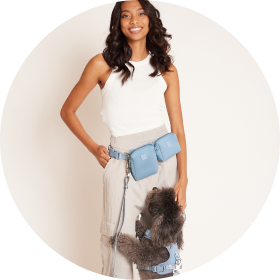- Home
- The Daily Wag!
- Senses
- Can Dogs Live Without Eyes?
Can Dogs Live Without Eyes?
Introduction
You've probably been at a dog park or bopping about town with your little pup when you've noticed a pooch strolling around town either missing one eye - or worse, both. If you've never seen this, you might have found yourself wondering, " can my dog live without his eyes?"
The good news: of course he can! While it's never an incredibly positive thing for a dog to undergo enucleation (the surgical removal of an eye), often, it can be a life saving or disease preventing surgery, and in most cases, won't bother your pup or reduce their quality of life in the slightest!
A lot of times, pups go through injuries, infections, diseases, or conditions that could cause damage to their eye and prompt doctors to remove it. Other times, pups are simply born without them. Either way, your doggo can certainly live without his eyes, and if you learn a few tricks to help accommodate him, the odds are he'll never know the difference.
If you're looking for tips about how to tell if your doggo is having eye trouble, tricks about how to make his life a little easier once his eyes are gone, or simply just want to share stories about your doggo's struggle without his eye(s), read on!
Signs That Your Pup May Need to Have His Eye(s) Removed
It's important to take note and pay attention to the signs your dog is giving you, especially when it comes to his eyes. Because dogs have heightened senses - like hearing and smelling - they're better at maneuvering their environments if their eyes are little off.
So well, in fact, you may take too long to notice they're having eye problems to begin with, which could lead to the removal of your pup's eyes.
If you want to keep a lookout for your pup's eye-health, make sure you're taking note about their behaviors. If your doggo is itching and scratching at his eyes a lot, that's a good indicator that there's something wrong. If you notice your dog bumping into things he normally wouldn't or running over and missing things that are routine for him, it's likely he's losing his vision.
If your pup has red or swollen eyes, whines or whimpers when you touch his eyes, has a noticeable opaqueness on his lenses, doesn't seem to respond to stimuli in front of his eyes, and more, then it's likely your pup is either losing vision in his eyes, or facing some sort of eye-related condition. Consulting a vet is the first step in dealing with these issues,
Historic Causes of Enuclation
It goes without saying that we'd likely always rather have our dogs with two healthy eyes intact. However, there are dozens of causes that can result in enucleation.
Historically, many of these causes are cancer, glaucoma, perforation, infection, or injury. Typically, the dogs who see most issues with their eyes and see most of the eye removal surgeries are pups who are brachycephalic dogs, meaning pups that have flat faces and prominent eyes (think Pugs, Bulldogs, and Boxers). They're simply more prone to injuries because their eyes bulge out.
The Science Behind Enuclation
Many dogs will need to have their eyes removed in their lifetime for a variety of reasons. Whether a dog has an infection, conditions like cancer or glaucoma, severe trauma, or is simply born with a defective eye, sometimes the option is enucleation.
Understanding the contributing factors to eye removal can often help owners either prevent the causes or embrace - and help the dog embrace - the changes that come with eye removal.
Eye removal surgery in dogs is a fairly common procedure that almost all canines will adapt to without issue. The goal of the surgery is to remove the eye and relieve the pain caused by the original condition of the eye that warranted the surgery.
The eye removal process isn't complicated and is fairly routine. After the eyeball is removed from the dog's socket, the edges of the eyelids will be permanently stitched together. Dogs recover well, quickly, and with minor pain following the surgery.
How to Train Your Dog to Deal With a Life Without Eyes
When training your pup to deal with his new way of life, it's important you teach him that consistency is key. Resist the urge to move furniture, rearrange the house, or switch up the location of his bowls. Instead, keep things in the same spot so your dog can develop a routine and remember where certain things are.
If you haven't already, crate train your dog so that he can have a safe, comfortable spot when you're gone. This way he won't have to roam endlessly throughout the house while you're gone.
Make sure your pup is familiar with the wait command. If you're ambitious, try training with a clicker - that can be especially helpful for dogs who have recently gone blind!
Written by a Great Dane lover Hanna Marcus
Veterinary reviewed by:
Published: 02/05/2018, edited: 04/06/2020
More articles by Hanna Marcus
